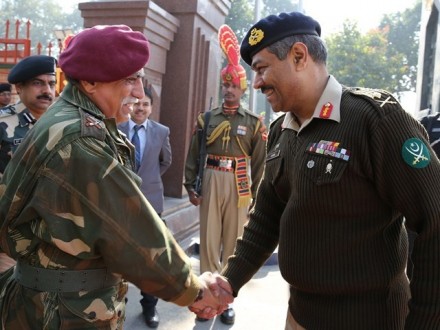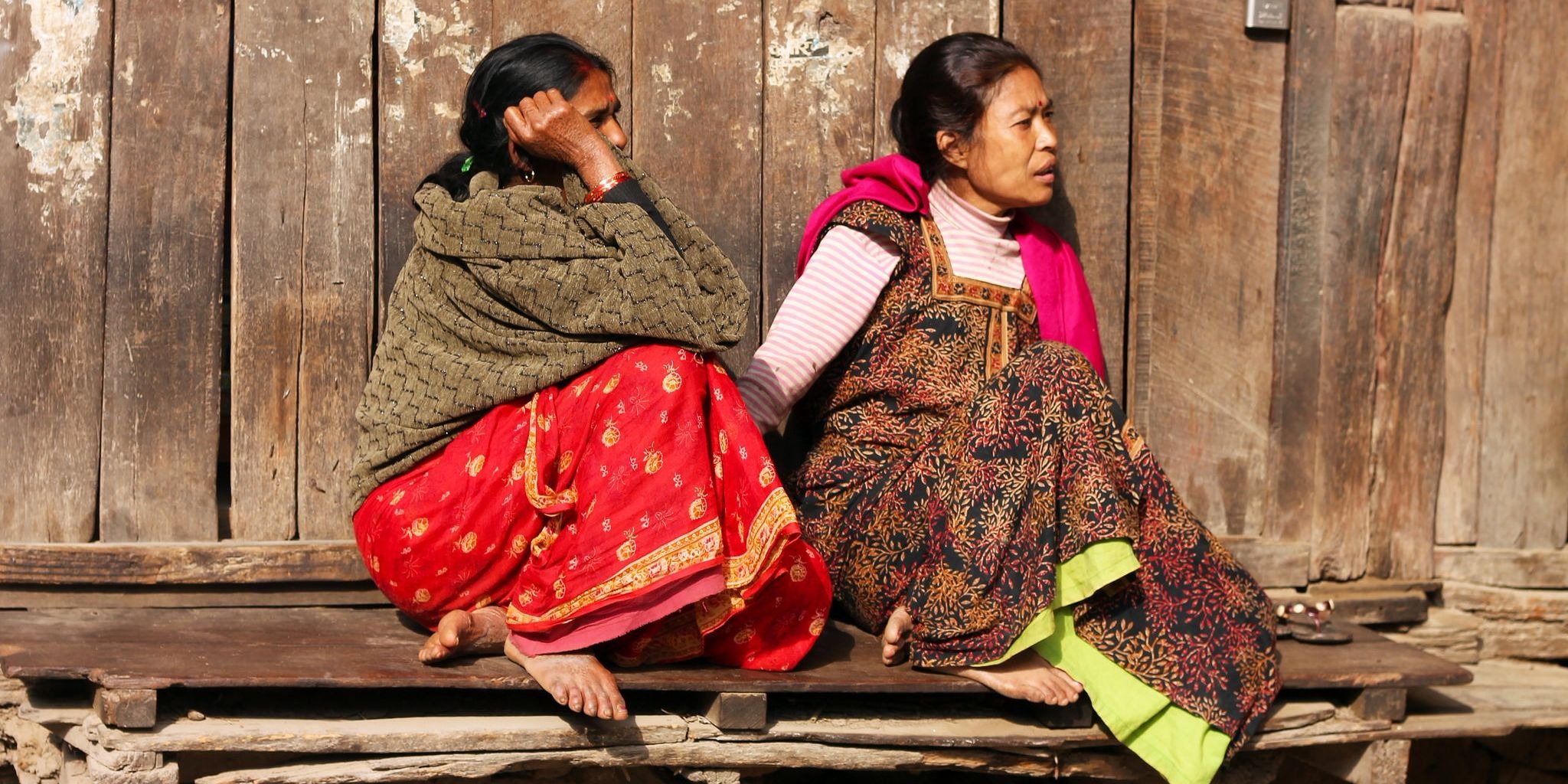Aditya Sondhi explains the nature of relations between India’s civilian and military authorities and explains why Pakistan’s experience has been drastically different.
 DGMO Pakistan Army Maj Gen Amir Riaz receives his Indian counterpart Lt Gen Vinod Bhatia at the Wagah border in January 2014.
DGMO Pakistan Army Maj Gen Amir Riaz receives his Indian counterpart Lt Gen Vinod Bhatia at the Wagah border in January 2014.
Q. You have drawn the distinction between armies that are loyal to governments of the day and those that serve the country. Why is this distinction useful when considering the civilian-military balance in South Asian countries?
A. Often, young South Asian countries find themselves in the midst of multiple power centres, all grappling for political space (Thailand is a classic example from South-East Asia). The army in these situations finds itself torn between serving the de facto government in power and the larger interests of the nation. The question that Lieutenant General S.K. Sinha pithily asks in his autobiography is: “a soldier owes allegiance to the constitution, but when he sees that constitution being systematically being destroyed, should he remain a silent spectator?” The army is not competent or entitled to ask or answer these questions. But the moment it does, regardless of the good intentions that may be involved, liberal democracy is the casualty. The army becomes a political player and vitiates the balance of power.
Q. What has kept the Indian civilian-military balance in check? Is this an attribute of individuals in the armed forces or the institutions?
A. A great deal of credit for the healthy civilian-military relations in India must go to the early generals, who were trained in the highest traditions of the British army to be professional soldiers. No more and no less. King George IV exempted his officers from drinking to his health or standing for the national anthem, as their loyalty could never be in doubt. This ethos has carried the Indian army forth, making it remain loyal to the civilian leadership of the day. But I must caveat here that the early generals of the Pakistan army were also from the same stock and no less professional. But the fact that they were given a taste of political power early coupled with the absence of other alternatives presented a fait accompli in Pakistan’s history.
Q. You have argued that the vacuum of strong civilian leaders in Pakistan in the years after Partition explains the military’s interventionist role in the country. Is this the main difference between the Pakistani and Indian trajectories in the context of the civilian-military balance?
A. I think this is the strongest reason for the nature of civil-military relations in the two countries. Pakistan had her constitution after a lapse of close to six years, by which time her tallest leader, Jinnah, had passed away and power was vested in bureaucrats. The people had no direct say in governance and the future of their young country. This is a delicate phase in the making of the DNA of any country, and the absence of strong, democratic leaders led to the military being seen as the only institution that was sincere and nationalistic. The fatal error came from Prime Minister Nazimuddin who invited the army under General Ayub Khan to quell sectarian riots in the Punjab province, permitting the army to dominate the political high table of its nation. India not only had strong civilian leaders at her birth with a leaning toward democratic practices, but also leaders who distrusted the army and saw it as a remnant of the Raj that had not involved itself in the freedom movement. The army has therefore been not ‘politically relevant’ since India’s inception.
Q. Is the relationship between India’s armed forces and its civilian authorities defined more by past engagements with Pakistan or China?
A. A bit of both. India’s 1962 war with China revealed the breakdown in leadership and the yawning trust-deficit between generals and the political class. It is to the credit of both that the ignominy of the war led to much soul-searching. The phase thereafter led to improved transparency between the civilian and military leadership and an emphasis on the indigenous growth of defence industries. The 1965 war with Pakistan quickly proved how much things had improved, while the conflict in 1971 clinched the situation—this was a war during which ministers listened to their chiefs and did not impose their will. The DGMO General Gill recalls how he often walked out of meetings with the prime minister and the Raksha Mantri due to “the incessant chatter”. This was taken on the chin and civilian-military relations became healthier than ever before.
Q. What role have courts played in India and Pakistan in establishing the civilian-military balance?
A. The courts have been seminal in both countries, for contrasting reasons. The Supreme Court in India has become her most powerful organ, and determines the scope of parliamentary power. It decides the basic structure of the constitution and binds the government and the people to it. This has checked despotism and adventurism by any other organ of the state. More importantly, it has given the country a ‘last-word institution’ and has ruled out the possibility of the army being that institution The army now needs to look no further than the orders of the Supreme Court to decide what is constitutionally legitimate.
In Pakistan, the Supreme Court has actually enabled military rule by upholding martial law on the doctrine of necessity despite there being no express provision for it in the constitution. The army has developed with such lopsided political power that there is really no check on those powers now. Though civil society in Pakistan is now vigorously questioning the army’s role in the political spectrum, a stronger Supreme Court could have reined in its powers much earlier and to greater avail. In some ways, the army is the ‘last-word institution’ in Pakistan. It decides national priorities and the character of national interest. Other institutions seemingly toe the line.
Q. What impact has the role of the military and paramilitary forces in Kashmir had on the civilian-military balance in India?
A. Marginal, really. This is because Kashmir is not the final frontier of relations with Pakistan for India, though it appears to determine the way Pakistan relates to her neighbour. By this I mean that the army (in Pakistan) plays up the issue of Kashmir to keep itself relevant in public perception. For Indians, the presence of the military in Kashmir is viewed in two ways: one, as a trained force doing its job and with no other political ramifications; and two, as a potential human rights dilemma that needs to be addressed.
Q. India has emerged as a major arms importer in recent years. What challenges does this era of rapid militarisation pose to India’s civilian-military balance?
A. Ironically, the armed forces in India are well behind their optimal strength in terms of arms and resources. For procurements, they remain dependent on the defence ministry, which is not necessarily proactive in such matters. We must also notice the difference here between militarisation and praetorianism. Fortunately, the former does not automatically lead to the latter (at least in India) and the military remains obedient to its political masters.
Q. Are there any examples of the Indian armed forces engaging in political adventurism? What lessons can India draw from these?
A. There are no such examples. I have argued, to the credit of the army, that despite several prevalent situations where other armies would have acted up, the Indian army has remained impassive. These instances include the breakdown in relations between the defence minister and the army chief in 1958-59, the Emergency of 1977, the 1962 war, Operation Blue Star, and the Indian Peace Keeping Force’s stint in Sri Lanka, where the army was shoved into a skewed operation. By remaining politically passive during these critical phases, the army has actually enabled democratic spaces to grow and be filled by other representative civilian institutions.
Q. How do the Indian armed forces manage linguistic, ethnic and religious diversity and what implications does this have for Indian secularism more broadly?
A. The Indian armed forces are a melting pot of cultures and communities. A mix of races find themselves working and fighting together. The regimental izzat (honour) overrides all other considerations. This makes for a truly secular organisation that remains a torchbearer for the rest of the country. I have repeatedly argued that this attribute of the army should make it far more socially relevant to the rest of the nation than it is today.
About the Author
Aditya Sondhi practices law in Bangalore and New Delhi, and is also a part-time professor. His PhD was on the interface between the army and democracy in India and Pakistan.






